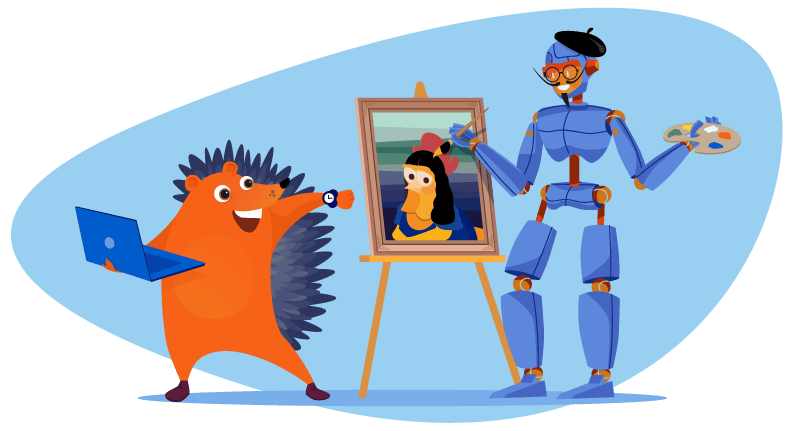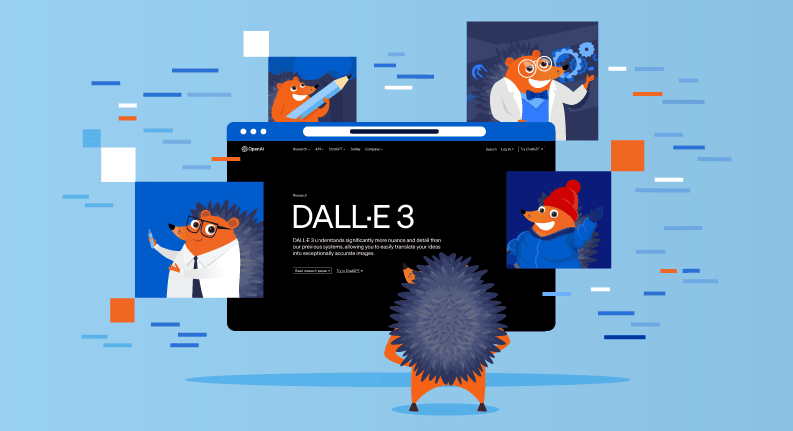
In the realm of artificial intelligence, GPT often steals the spotlight. However, there’s another innovative creation making waves: DALL-E. Developed by OpenAI, the same company behind ChatGPT, DALL-E is designed to generate visual content based on textual inputs.
The technology behind DALL-E is more complex than that. Today, we’re delving into DALL-E, exploring its inner workings, and how it’s revolutionizing graphic design, websites, and more.
History of DALL-E: Transforming language into visual art
DALL-E, later succeeded by DALL-E 2 and DALL-E 3, represents OpenAI’s groundbreaking effort to bridge language and visuals using deep learning methodologies. Rooted in the GPT series, these models have the ability to create digital images from textual cues or prompts.
We’ll dive deeper into DALL-E’s inner workings in a moment. First, let’s explore how it came to be what it is today. Here’s a brief overview of its inception and evolution:
- January 2021: OpenAI launched the maiden version, DALL-E, which was an adaptation of GPT-3 designed to produce images.
- April 2022: DALL-E 2 was introduced, boasting superior realism in image production and exhibiting a penchant for melding concepts, attributes, and styles with finesse.
- September 2023: OpenAI unveiled DALL-E 3, the current model heralded for its unparalleled sophistication in discerning nuances and intricate details in prompts.
What Is DALL-E?
At its core, DALL-E is similar to GPT-3, both being transformer language models. However, while GPT-3 processes and produces textual data, DALL-E interprets and generates visual content from textual prompts. It’s the same and yet very different. So, how does DALL-E work?
The artificial intelligence learns from a huge collection of pictures paired with descriptions. This allows it to create objects and creatures that feel surprisingly human, blending wild ideas in ways that seem totally real, having fun with words, and smartly changing up photos we’re familiar with.
DALL-E amalgamates text and image as a unified data stream of up to 1,280 tokens at once. For clarity, a token can be any symbol from a defined vocabulary. Here, DALL-E’s vocabulary accommodates both textual and visual concepts.
The training enables DALL-E to create an image from scratch or modify specific parts of an existing image, whether it’s a photo-realistic image or a fashion design sketch, in line with the given text prompt.
What can DALL-E do: Interesting use cases and integrations
DALL-E’s primary strength lies in its ability to fabricate plausible images from words. But perhaps what makes DALL-E so formidable is its ability to understand the intricate structures of language.
Indeed, it is proficient in varying attributes of objects and can manipulate the frequency of their appearance based on the provided descriptions. One of the most incredible things it can do is blend totally different ideas together, turning what you imagine with words into something you can see.
However, with DALL-E 3 now an integral part of ChatGPT (Pro plans only), plenty of interesting possibilities arise, mainly in terms of automated workflows. For instance, you can view documents in a React app, establish your tasks with them, upload them to ChatGPT’s Advanced Data Analysis tab, and then use DALL-E 3 to generate images.
This can be great for blog posts, data visualization (the Wolfram plugin is still good for that), mockups for manual designs, and so much more.
The research surrounding DALL-E
The success and prowess of DALL-E 3 are not merely fortuitous. It’s born from tireless exploration and innovation, both inside OpenAI’s walls and beyond. Compared to its predecessor, DALL-E 3 produces images of superior quality, attention to detail, and adherence to user-supplied descriptions.
This enhancement was realized by employing a state-of-the-art image captioner to generate enhanced textual descriptions, which, in turn, served as the training data for DALL-E 3.
Challenges and limitations
As the adage goes, “With great power comes great responsibility.” Generative models like DALL-E are indeed powerful, opening doors to all kinds of possibilities. However, OpenAI is not blind to the challenges and potential pitfalls.
Censorship
They’ve initiated robust safety mechanisms to tackle the risk of creating harmful imagery, be it violent, inappropriate, or brimming with hate.
This approach is dual-faceted: not only are user prompts analyzed, but the ensuing imagery is as well, ensuring that inappropriate content never reaches the user.
The contribution of early users and domain experts in refining this system can’t be understated. Their feedback has been pivotal in strengthening the safety measures in place.
Yes, although both Bing Image Creator and DALL-E have tightened their censorship for ethical reasons in recent weeks, it’s not the end of the world just because you can’t generate Jean-Luc Picard driving a Dodge Challenger.
Remember, all objects or scenes that aren’t copyrighted or vulgar can be created, which means the use cases are pretty much endless. You can generate batches of images for a personal grocery shopper app, spice up your blogs, or even visualize data. However, the limitations are still there, and it’s pointless to expect images that don’t require at least a little bit of editing.
We’re not quite there yet
Although the third iteration of this visually oriented AI certainly blew people’s minds, it’s not the one-size-fits-all solution everyone hoped for.
“We tried everything from using DALL-E for promotional images to asking it to edit our existing visual content, now that ChatGPT Vision is integrated with the platform,” says Andrew Cuthbert, Head of Organic Marketing at unicorn software startup Weave. “It’s great for brainstorming, but we’re still far, far away from publishable images in a few seconds.”
So, it would be best to treat DALL-E as the next step towards the ideal generative AI for visuals. We still can’t rely on it fully, as it has issues with lettering, racial bias, and much more.
While technological advancements are at the forefront, OpenAI places immense value on the insights drawn from its vast user community. Their experiences, challenges, and feedback steer the course for refining and reshaping the models.
The challenge of authenticity
In a time when AI-crafted visuals are everywhere, it’s vital to distinguish between what’s real and what’s AI-made. OpenAI is addressing this with the development of a provenance classifier. Basically, this tool can tell whether an image has DALL-E 3’s “fingerprints” on it.
Implications for designers
The emergence of DALL-E and its successors has been revolutionary for the design realm. Just as the chisel was to a sculptor or the brush to a painter in bygone eras, this AI-driven tool is redefining the canvas of contemporary designers.
But like any tool, it carries with it both promises and challenges. Let’s explore what this means for designers today.
Enhanced productivity and efficiency
Designers are always on the lookout for ways to refine and expedite their processes. With DALL-E, rapid prototyping is now a reality. Imagine being in a brainstorming session and bringing a conceptual idea to visual life in mere moments.
The iterative design process, often characterized by multiple rounds of feedback and tweaks, can now be streamlined. With AI assistance, designers can adjust and experiment with designs at an unprecedented pace.
Economic and personalized impacts
When it comes to money matters, AI can make design more accessible to everyone by making it cheaper. But there’s a real worry that it might take away jobs, especially ones that have a lot of repeat tasks.
In the online world, it’s all about making things personal. With AI crafting designs, we might get images that are just our style, making our time online even more enjoyable.
Designing for a sustainable future
Think about the green impact. AI can be utilized to craft designs with the least environmental footprint, from the things we use to where we live.
Design is always changing, and DALL-E is just the newest player in this story. For designers, the real task is using these tools wisely. We must innovate while still keeping true to what’s right, real, and the age-old basics of good design.
What’s next for visual AI?
For starters, DALL-E 3 has been engineered to decline requests mimicking the style of living artists, emphasizing respect for originality. Additionally, creators have the prerogative to exclude their images from being used in the training of subsequent image-generation models.
With tools like DALL-E coming into the picture, we’re on the edge of a big change in graphic design and how websites look. Using AI in visuals means we might soon live in a world where what we imagine with words can instantly turn into images, opening up endless creative possibilities.
For more about generative AI, check out the breakdown from our own Undercover Geek.


